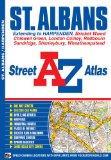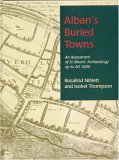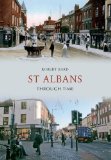- UK Information
- UK Guidebooks and Maps
- St. Albans books and maps
St. Albans books and maps
Here is a list of books for St. Albans that you may find useful.If you plan to travel to St. Albans you may be interested in some guide books and travel books that will help you plan your stay in St. Albans and to find your way around. Click on any book for more information or to buy.
St. Albans books: Maps
Ordnance Survey Explorer Map 182 St. Albans & Hatfield, Hemel Hempstead & Welwyn Garden City
OS Explorer Map is the Ordnance Survey's most detailed map and is recommended for anyone enjoying outdoor activities like walking, horse riding and off-road cycling. Providing complete GB coverage the series details essential information such as youth hostels, pubs and visitor information as well as rights of way, permissive paths and bridleways.
Price: £5.99
Publication: 8 Feb 2006


OS Explorer Map is the Ordnance Survey's most detailed map and is recommended for anyone enjoying outdoor activities like walking, horse riding and off-road cycling. Providing complete GB coverage the series details essential information such as youth hostels, pubs and visitor information as well as rights of way, permissive paths and bridleways.
Price: £5.99
Publication: 8 Feb 2006


St. Albans books: History & Heritage
Alban's Buried Towns: An Assessment of St. Albans' Archaeology Up to AD 1600
St Albans has a long tradition of archaeological investigation dating back to the 18th century. What has been lacking however, is a detailed synthesis and interpretation of the accumulated information. This book is intended to meet that need, and comes out of a project set up by English Heritage in 1992 designed to promote 'intensive' urban archaeological strategy. This volume is a critical assessment of the current archaeological information from an area of 12 square kilometers centred on medieval and modern St Albans and its Roman predecessor, Verulamium. There is evidence of scattered occupation in the area from the Mesolithic period onwards, but it was only towards the end of the 1st century BC that a settlement was established to the south of the modern town. This was superseded by the development of the Roman town of Verulamium on the south side of the River Ver, but by the 8th century settlement had become focused on the shrine of the late Roman martyr, Alban, on the hill to the north of the river. In the late Saxon period an Abbey was established close to this shrine, and after the Norman conquest, settlement concentrated in the area north of the Abbey. Most of the monastic buildings were demolished shortly after the dissolution of the monastery in 1539, but on the whole St Albans retained its medieval form until the 19th century. The papers in this volume look at the development of this important city throughout its long history, bringing its Roman and Medieval past to life.
Price: £35.28
Publication: February 2006


St Albans has a long tradition of archaeological investigation dating back to the 18th century. What has been lacking however, is a detailed synthesis and interpretation of the accumulated information. This book is intended to meet that need, and comes out of a project set up by English Heritage in 1992 designed to promote 'intensive' urban archaeological strategy. This volume is a critical assessment of the current archaeological information from an area of 12 square kilometers centred on medieval and modern St Albans and its Roman predecessor, Verulamium. There is evidence of scattered occupation in the area from the Mesolithic period onwards, but it was only towards the end of the 1st century BC that a settlement was established to the south of the modern town. This was superseded by the development of the Roman town of Verulamium on the south side of the River Ver, but by the 8th century settlement had become focused on the shrine of the late Roman martyr, Alban, on the hill to the north of the river. In the late Saxon period an Abbey was established close to this shrine, and after the Norman conquest, settlement concentrated in the area north of the Abbey. Most of the monastic buildings were demolished shortly after the dissolution of the monastery in 1539, but on the whole St Albans retained its medieval form until the 19th century. The papers in this volume look at the development of this important city throughout its long history, bringing its Roman and Medieval past to life.
Price: £35.28
Publication: February 2006


St Albans 1650-1700: A Thoroughfare Town and Its People
The urban history of Britain is being pursued with new vigour and new objectives and its problems tackled through important local studies of social and economic change in Chester, Shrewsbury and Uttoxeter and more recently by studies of smaller towns such as St Albans. This study of St Albans covers the period from the Commonwealth to the accession of Anne which embraces religious and political changes of great interest in the life of a town of strongly dissenting opinion. Curiosity about this critical period in the growth of the city led the St Albans and Hertfordshire Architectural and Archaeological Society to establish its Seventeenth Century Research Group whose members set out to discover what the town's churches and houses looked like, changes in population, how people earned a living, social structure, religious beliefs and political attitudes. Several features of their research assembled here are unusual in local history writing. Population statistics include an age profile, age at marriage, size of family, crisis years and age at death - with an astonishing infant mortality. Architectural evidence, used to link the death rate to overcrowding caused by intensive development of the town centre, also demonstrates improvements in comfort and amenity and responses to fashion. The social structure and some typical families are described in detail, as is the administrative structure and its workings at both corporation and parish level. The economic background is that of a thoroughfare town, as much dependent on road transport as on its market function. A large database revealed an unusually high proportion of nonconformists and a surprising degree of co-operation between them and the established church, despite the very public murder of one of their number by an ex-Cavalier officer. A tentative explanation is also offered for an equally surprising political change - how the corporation of St Albans, staunchly Cromwellian in outlook in 1650, came, in little more than a generation, to support James II's policies in 1685.
Price: £14.73
Publication: 5 Dec 2003


The urban history of Britain is being pursued with new vigour and new objectives and its problems tackled through important local studies of social and economic change in Chester, Shrewsbury and Uttoxeter and more recently by studies of smaller towns such as St Albans. This study of St Albans covers the period from the Commonwealth to the accession of Anne which embraces religious and political changes of great interest in the life of a town of strongly dissenting opinion. Curiosity about this critical period in the growth of the city led the St Albans and Hertfordshire Architectural and Archaeological Society to establish its Seventeenth Century Research Group whose members set out to discover what the town's churches and houses looked like, changes in population, how people earned a living, social structure, religious beliefs and political attitudes. Several features of their research assembled here are unusual in local history writing. Population statistics include an age profile, age at marriage, size of family, crisis years and age at death - with an astonishing infant mortality. Architectural evidence, used to link the death rate to overcrowding caused by intensive development of the town centre, also demonstrates improvements in comfort and amenity and responses to fashion. The social structure and some typical families are described in detail, as is the administrative structure and its workings at both corporation and parish level. The economic background is that of a thoroughfare town, as much dependent on road transport as on its market function. A large database revealed an unusually high proportion of nonconformists and a surprising degree of co-operation between them and the established church, despite the very public murder of one of their number by an ex-Cavalier officer. A tentative explanation is also offered for an equally surprising political change - how the corporation of St Albans, staunchly Cromwellian in outlook in 1650, came, in little more than a generation, to support James II's policies in 1685.
Price: £14.73
Publication: 5 Dec 2003


St Albans Through Time
As one of the earliest recorded towns in Britain, St Albans has had a long, colourful and distinguished history. Dominated by the great Abbey Church of St Alban, the adjacent site was a thriving market town in Saxon, Norman, medieval and Georgian times. The coming of the railway in the mid nineteenth century saw increased development to the east of the original settlement, and this has been steadily growing ever since. St Albans was one of the sites where Magna Carta was drafted. It played a great part in the Peasants' Revolt, and took Parliament's side in the Civil War. Each of these periods has left its mark on the architecture and environment. Today St Albans is still a thriving market town, a focus for commuters and a magnet for tourists. All this and more is captured in this remarkable book, celebrating the vibrant life of this most historic area.
Price: £14.99
Publication: 3 April 2012


As one of the earliest recorded towns in Britain, St Albans has had a long, colourful and distinguished history. Dominated by the great Abbey Church of St Alban, the adjacent site was a thriving market town in Saxon, Norman, medieval and Georgian times. The coming of the railway in the mid nineteenth century saw increased development to the east of the original settlement, and this has been steadily growing ever since. St Albans was one of the sites where Magna Carta was drafted. It played a great part in the Peasants' Revolt, and took Parliament's side in the Civil War. Each of these periods has left its mark on the architecture and environment. Today St Albans is still a thriving market town, a focus for commuters and a magnet for tourists. All this and more is captured in this remarkable book, celebrating the vibrant life of this most historic area.
Price: £14.99
Publication: 3 April 2012


St. Albans books: General Interest
Luton, Hertford, Hitchin & St Albans (OS Landranger Map)
Perfect for day trips and short breaks, the OS Landranger Map series covers Great Britain with 204 detailed maps. Each map provides all the information you need to get to know your local area and includes places of interest, tourist information, picnic areas and camp sites, plus Rights of Way information for England and Wales.
Price: £5.24
Publication: 15 May 2012


Perfect for day trips and short breaks, the OS Landranger Map series covers Great Britain with 204 detailed maps. Each map provides all the information you need to get to know your local area and includes places of interest, tourist information, picnic areas and camp sites, plus Rights of Way information for England and Wales.
Price: £5.24
Publication: 15 May 2012


The St. Albans books listed on this page are for your information and to help you find the books you need quickly. We do not endorse any particular books and are not responsible for the advice and information in the books listed.
The price of books, where indicated, was correct at the time the book was added to this page. Prices may have changed on the booksellers web site.






